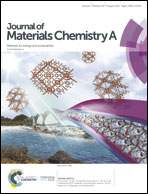Superflexible C68-graphyne as a promising anode material for lithium-ion batteries†
Abstract
The breakthrough in the synthesis of graphyne, graphdiyne and graph-4-yne stimulates interest in studying new members of the graphyne family for promising applications. In this work, a new allotrope of graphyne with excellent stability and an ultrahigh specific surface area of 4255 m2 g−1, named C68-graphyne, is predicted by first principles calculations. Mechanical tests reveal that C68-graphyne exhibits much smaller in-plane tensile stiffness (∼50.5 N m−1) and out-of-plane bending stiffness (∼0.5 eV) than graphene (in-plane tensile stiffness 350 N m−1 and out-of-plane bending stiffness 1.4 eV), suggesting C68-graphyne as a superflexible material. Meanwhile, our results show that monolayer C68-graphyne is a semiconductor with a direct band gap of 1.0 eV, which can be tuned by strain-engineering, and the calculated carrier mobility is as high as 1.81 × 105 to 2.97 × 105 cm2 V−1 s−1 at 300 K. Finally, the potential application of C68-graphyne as an anode material for lithium-ion batteries is explored and predicted. The calculated results show highly efficient charge transfer from the adsorbed Li ions to C68-graphyne yet a low diffusion barrier for Li ions in C68-graphyne for fast charge/discharge rates. The storage capacities for Li in monolayer and bilayer C68-graphyne are calculated to be as high as 1954 and 1675 mA h g−1, respectively. These features make C68-graphyne a promising anode material for lithium-ion batteries with excellent energy storage capacities as well as fast charge/discharge rates.



 Please wait while we load your content...
Please wait while we load your content...